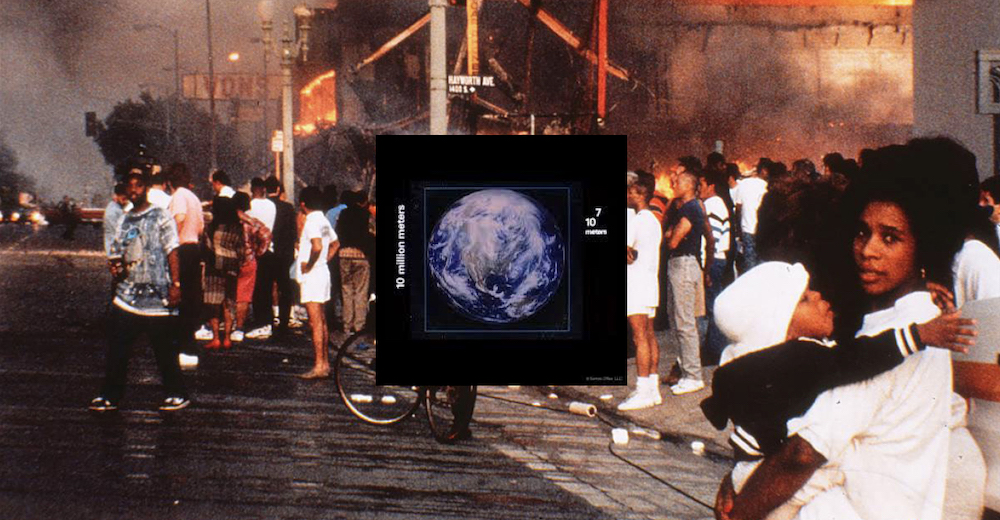What does it mean to watch something live and die in the same moment? What does it mean to be Black in America right now? In their first two-person collaboration titled Ozone Atmosphere, Monsieur Zohore and Sandy Williams IV explore disparate ideas about the inevitability of the world ending and the transitory nature of Black life. During the artists’ lifetime, concerns about depletions in the ozone layer and climate change have permeated our social consciousness, nationally and globally. In recent years the words climate, weather, and atmosphere have also been used to describe the totalizing ways that anti-Blackness circumscribes race relations within and beyond the U.S. Zohore employs humor and domestic labor to critique cultural expectations that arise from consumer-driven capitalism and his Ivory Coast parentage. In pursuit of threads that connect Black diasporic origin stories to official records and colloquial histories, Williams confronts memory, the body, and practices of resistance. By linking ozone depletion with anti-Blackness, the artists investigate how oppressive forces affect everyday gestures such as breathing and simply existing at the level of the environment and Black identity.
Thematically, contemporary culture and current events such as living through a pandemic and a new era of racial reckoning infuse the works in Ozone Atmosphere with a fleeting urgency that finds kindred expression in immateriality and impermanence. Zohore’s dragon balls live in Plexiglas boxes amid grass that will wither and die during the course of the exhibition. A reference to the Japanese animated series of the same name where the characters journey to resurrect lost loved ones, each set of Zohore’s dragon balls memorializes either one of the artist’s kin or a significant historical figure. Nearby, Williams’s wax candle sculptures and family portraits, both of which mimic the form of equestrian monuments, slowly melt and fade as his alluringly transparent backpacks mark time and memory. Within these works, bleach, fabric dye, resin, and paper towels comingle with wax and time-based media just as fact mixes with fiction in an increasingly uncertain world.
Conceptually and formally, the works pivot on perspective, duplicity, and the body as surface. The objects all change depending on the viewer’s position and presence, and all of the objects engage viewers in one obvious sense but then perform something different. Meanwhile, the artists’ manipulations of material surfaces sidestep stereotypical imaginings of the Black male body. In a gigabyte video comprised of one long shot, Williams lies in his bed naked—a revised take on the art historical tradition of the reclining nude. His miniscule, mundane movements suggest repose as well as stagnancy. Zohore’s paper towel “paintings,” on the other hand, transform the surface—the body—of the work. Canvas substrates covered in layers of paper towels imprinted with images culled from popular culture approximate paintings but they are in fact sculptures. Zohore’s half-real, half-fake birds of paradise rooted in Windex function similarly. Rather than a vibrant flowering plant in fertile soil, his birds of paradise start to bloom then die before realizing their full potential.
By focusing on the atmospheric overlaps between their work and their own Black (male) experiences, the artists compose a compelling visual dance—a duet—that extends Black conceptual art traditions to new forms of abstraction and surrealism. Looking to the stars and lucid dreaming are key to these new forms, both of which are realized in Zohore’s telescope sculpture. Engraved with a line from Langston Hughes’s 1921 poem, “Stars,” the telescope acts as a portal to the sky while the accompanying stars that Zohore purchases for victims of racial and sexual violence act as memorials. Here the sky, much like the ozone layer and Blackness, becomes a sort of skin for the artists. It is porous, able to absorb and reflect, and it is an abstraction. In Williams’s words, it occupies the “space between the Earth of our present and the projected Space-futurisms that we envision and extend beyond our bodies far into parallel universes. This exhibition is an attempt to understand our air quality, not as simple or thin-skinned, but as the complicated environment where we both breathe and ‘cannot breathe.’” Ultimately, Ozone Atmosphere constructs a new vision of identity-based art. Across media and genre, the works ebb and flow with the challenges of our time.
– Tiffany E. Barber
Learn More